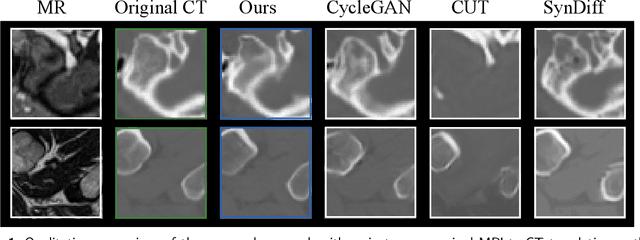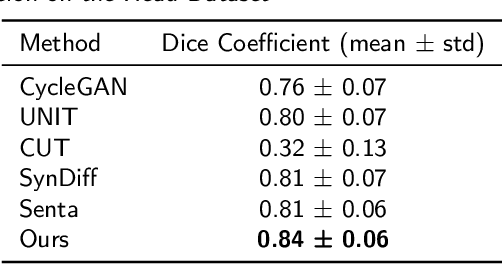Image To Image Translation
Image-to-image translation is the process of converting an image from one domain to another using deep learning techniques.
Papers and Code
The Role of AI in Early Detection of Life-Threatening Diseases: A Retinal Imaging Perspective
May 27, 2025Retinal imaging has emerged as a powerful, non-invasive modality for detecting and quantifying biomarkers of systemic diseases-ranging from diabetes and hypertension to Alzheimer's disease and cardiovascular disorders but current insights remain dispersed across platforms and specialties. Recent technological advances in optical coherence tomography (OCT/OCTA) and adaptive optics (AO) now deliver ultra-high-resolution scans (down to 5 {\mu}m ) with superior contrast and spatial integration, allowing early identification of microvascular abnormalities and neurodegenerative changes. At the same time, AI-driven and machine learning (ML) algorithms have revolutionized the analysis of large-scale retinal datasets, increasing sensitivity and specificity; for example, deep learning models achieve > 90 \% sensitivity for diabetic retinopathy and AUC = 0.89 for the prediction of cardiovascular risk from fundus photographs. The proliferation of mobile health technologies and telemedicine platforms further extends access, reduces costs, and facilitates community-based screening and longitudinal monitoring. Despite these breakthroughs, translation into routine practice is hindered by heterogeneous imaging protocols, limited external validation of AI models, and integration challenges within clinical workflows. In this review, we systematically synthesize the latest OCT/OCT and AO developments, AI/ML approaches, and mHealth/Tele-ophthalmology initiatives and quantify their diagnostic performance across disease domains. Finally, we propose a roadmap for multicenter protocol standardization, prospective validation trials, and seamless incorporation of retinal screening into primary and specialty care pathways-paving the way for precision prevention, early intervention, and ongoing treatment of life-threatening systemic diseases.
A 2D Semantic-Aware Position Encoding for Vision Transformers
May 14, 2025



Vision transformers have demonstrated significant advantages in computer vision tasks due to their ability to capture long-range dependencies and contextual relationships through self-attention. However, existing position encoding techniques, which are largely borrowed from natural language processing, fail to effectively capture semantic-aware positional relationships between image patches. Traditional approaches like absolute position encoding and relative position encoding primarily focus on 1D linear position relationship, often neglecting the semantic similarity between distant yet contextually related patches. These limitations hinder model generalization, translation equivariance, and the ability to effectively handle repetitive or structured patterns in images. In this paper, we propose 2-Dimensional Semantic-Aware Position Encoding ($\text{SaPE}^2$), a novel position encoding method with semantic awareness that dynamically adapts position representations by leveraging local content instead of fixed linear position relationship or spatial coordinates. Our method enhances the model's ability to generalize across varying image resolutions and scales, improves translation equivariance, and better aggregates features for visually similar but spatially distant patches. By integrating $\text{SaPE}^2$ into vision transformers, we bridge the gap between position encoding and perceptual similarity, thereby improving performance on computer vision tasks.
LeDiFlow: Learned Distribution-guided Flow Matching to Accelerate Image Generation
May 27, 2025Enhancing the efficiency of high-quality image generation using Diffusion Models (DMs) is a significant challenge due to the iterative nature of the process. Flow Matching (FM) is emerging as a powerful generative modeling paradigm based on a simulation-free training objective instead of a score-based one used in DMs. Typical FM approaches rely on a Gaussian distribution prior, which induces curved, conditional probability paths between the prior and target data distribution. These curved paths pose a challenge for the Ordinary Differential Equation (ODE) solver, requiring a large number of inference calls to the flow prediction network. To address this issue, we present Learned Distribution-guided Flow Matching (LeDiFlow), a novel scalable method for training FM-based image generation models using a better-suited prior distribution learned via a regression-based auxiliary model. By initializing the ODE solver with a prior closer to the target data distribution, LeDiFlow enables the learning of more computationally tractable probability paths. These paths directly translate to fewer solver steps needed for high-quality image generation at inference time. Our method utilizes a State-Of-The-Art (SOTA) transformer architecture combined with latent space sampling and can be trained on a consumer workstation. We empirically demonstrate that LeDiFlow remarkably outperforms the respective FM baselines. For instance, when operating directly on pixels, our model accelerates inference by up to 3.75x compared to the corresponding pixel-space baseline. Simultaneously, our latent FM model enhances image quality on average by 1.32x in CLIP Maximum Mean Discrepancy (CMMD) metric against its respective baseline.
Enhancing Synthetic CT from CBCT via Multimodal Fusion: A Study on the Impact of CBCT Quality and Alignment
Jun 10, 2025



Cone-Beam Computed Tomography (CBCT) is widely used for real-time intraoperative imaging due to its low radiation dose and high acquisition speed. However, despite its high resolution, CBCT suffers from significant artifacts and thereby lower visual quality, compared to conventional Computed Tomography (CT). A recent approach to mitigate these artifacts is synthetic CT (sCT) generation, translating CBCT volumes into the CT domain. In this work, we enhance sCT generation through multimodal learning, integrating intraoperative CBCT with preoperative CT. Beyond validation on two real-world datasets, we use a versatile synthetic dataset, to analyze how CBCT-CT alignment and CBCT quality affect sCT quality. The results demonstrate that multimodal sCT consistently outperform unimodal baselines, with the most significant gains observed in well-aligned, low-quality CBCT-CT cases. Finally, we demonstrate that these findings are highly reproducible in real-world clinical datasets.
RoboFAC: A Comprehensive Framework for Robotic Failure Analysis and Correction
May 18, 2025Vision-Language-Action (VLA) models have recently advanced robotic manipulation by translating natural-language instructions and image information into sequential control actions. However, these models often underperform in open-world scenarios, as they are predominantly trained on successful expert demonstrations and exhibit a limited capacity for failure recovery. In this work, we present a Robotic Failure Analysis and Correction (RoboFAC) framework to address this issue. Firstly, we construct RoboFAC dataset comprising 9,440 erroneous manipulation trajectories and 78,623 QA pairs across 16 diverse tasks and 53 scenes in both simulation and real-world environments. Leveraging our dataset, we develop RoboFAC model, which is capable of Task Understanding, Failure Analysis and Failure Correction. Experimental results demonstrate that the RoboFAC model outperforms GPT-4o by 34.1% on our evaluation benchmark. Furthermore, we integrate the RoboFAC model into a real-world VLA control pipeline as an external supervision providing correction instructions, yielding a 29.1% relative improvement on average on four real-world tasks. The results show that our RoboFAC framework effectively handles robotic failures and assists the VLA model in recovering from failures.
Low-Resource Language Processing: An OCR-Driven Summarization and Translation Pipeline
May 16, 2025This paper presents an end-to-end suite for multilingual information extraction and processing from image-based documents. The system uses Optical Character Recognition (Tesseract) to extract text in languages such as English, Hindi, and Tamil, and then a pipeline involving large language model APIs (Gemini) for cross-lingual translation, abstractive summarization, and re-translation into a target language. Additional modules add sentiment analysis (TensorFlow), topic classification (Transformers), and date extraction (Regex) for better document comprehension. Made available in an accessible Gradio interface, the current research shows a real-world application of libraries, models, and APIs to close the language gap and enhance access to information in image media across different linguistic environments
RoboSwap: A GAN-driven Video Diffusion Framework For Unsupervised Robot Arm Swapping
Jun 10, 2025Recent advancements in generative models have revolutionized video synthesis and editing. However, the scarcity of diverse, high-quality datasets continues to hinder video-conditioned robotic learning, limiting cross-platform generalization. In this work, we address the challenge of swapping a robotic arm in one video with another: a key step for crossembodiment learning. Unlike previous methods that depend on paired video demonstrations in the same environmental settings, our proposed framework, RoboSwap, operates on unpaired data from diverse environments, alleviating the data collection needs. RoboSwap introduces a novel video editing pipeline integrating both GANs and diffusion models, combining their isolated advantages. Specifically, we segment robotic arms from their backgrounds and train an unpaired GAN model to translate one robotic arm to another. The translated arm is blended with the original video background and refined with a diffusion model to enhance coherence, motion realism and object interaction. The GAN and diffusion stages are trained independently. Our experiments demonstrate that RoboSwap outperforms state-of-the-art video and image editing models on three benchmarks in terms of both structural coherence and motion consistency, thereby offering a robust solution for generating reliable, cross-embodiment data in robotic learning.
Multimodal Machine Translation with Visual Scene Graph Pruning
May 26, 2025Multimodal machine translation (MMT) seeks to address the challenges posed by linguistic polysemy and ambiguity in translation tasks by incorporating visual information. A key bottleneck in current MMT research is the effective utilization of visual data. Previous approaches have focused on extracting global or region-level image features and using attention or gating mechanisms for multimodal information fusion. However, these methods have not adequately tackled the issue of visual information redundancy in MMT, nor have they proposed effective solutions. In this paper, we introduce a novel approach--multimodal machine translation with visual Scene Graph Pruning (PSG), which leverages language scene graph information to guide the pruning of redundant nodes in visual scene graphs, thereby reducing noise in downstream translation tasks. Through extensive comparative experiments with state-of-the-art methods and ablation studies, we demonstrate the effectiveness of the PSG model. Our results also highlight the promising potential of visual information pruning in advancing the field of MMT.
SocialCredit+
Jun 12, 2025SocialCredit+ is AI powered credit scoring system that leverages publicly available social media data to augment traditional credit evaluation. It uses a conversational banking assistant to gather user consent and fetch public profiles. Multimodal feature extractors analyze posts, bios, images, and friend networks to generate a rich behavioral profile. A specialized Sharia-compliance layer flags any non-halal indicators and prohibited financial behavior based on Islamic ethics. The platform employs a retrieval-augmented generation module: an LLM accesses a domain specific knowledge base to generate clear, text-based explanations for each decision. We describe the end-to-end architecture and data flow, the models used, and system infrastructure. Synthetic scenarios illustrate how social signals translate into credit-score factors. This paper emphasizes conceptual novelty, compliance mechanisms, and practical impact, targeting AI researchers, fintech practitioners, ethical banking jurists, and investors.
Path and Bone-Contour Regularized Unpaired MRI-to-CT Translation
May 06, 2025



Accurate MRI-to-CT translation promises the integration of complementary imaging information without the need for additional imaging sessions. Given the practical challenges associated with acquiring paired MRI and CT scans, the development of robust methods capable of leveraging unpaired datasets is essential for advancing the MRI-to-CT translation. Current unpaired MRI-to-CT translation methods, which predominantly rely on cycle consistency and contrastive learning frameworks, frequently encounter challenges in accurately translating anatomical features that are highly discernible on CT but less distinguishable on MRI, such as bone structures. This limitation renders these approaches less suitable for applications in radiation therapy, where precise bone representation is essential for accurate treatment planning. To address this challenge, we propose a path- and bone-contour regularized approach for unpaired MRI-to-CT translation. In our method, MRI and CT images are projected to a shared latent space, where the MRI-to-CT mapping is modeled as a continuous flow governed by neural ordinary differential equations. The optimal mapping is obtained by minimizing the transition path length of the flow. To enhance the accuracy of translated bone structures, we introduce a trainable neural network to generate bone contours from MRI and implement mechanisms to directly and indirectly encourage the model to focus on bone contours and their adjacent regions. Evaluations conducted on three datasets demonstrate that our method outperforms existing unpaired MRI-to-CT translation approaches, achieving lower overall error rates. Moreover, in a downstream bone segmentation task, our approach exhibits superior performance in preserving the fidelity of bone structures. Our code is available at: https://github.com/kennysyp/PaBoT.
 Add to Chrome
Add to Chrome Add to Firefox
Add to Firefox Add to Edge
Add to Edge